Durga Puja Inc. and ‘The Company Puja’
Posted by The Global Calcuttan on Friday, October 3, 2014 · 7 Comments
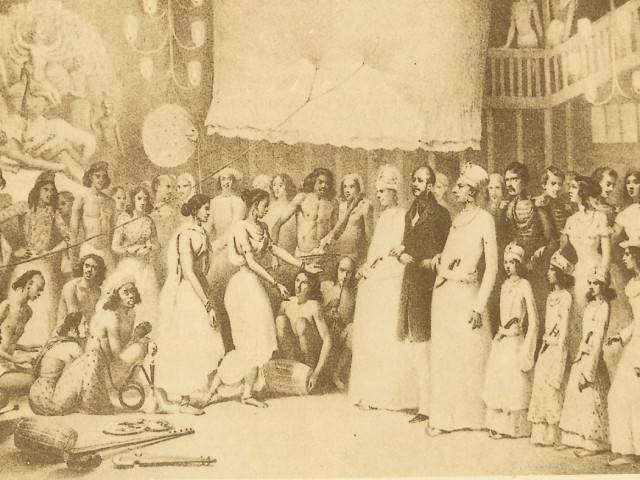
“The socially significant Barowari Pujas, which were established so the public dare not depend on the benevolence of the wealthy have devolved into mere corporate events, the community, transformed into event managers, the public reduced to the role of gawker, tourists in their own land..”
By SB Veda
CALCUTTA – The twelve rebellious men who started the first community or ‘Barowari’ (of 12 friends) celebration of Durga Puja, put together from meager donations at a time when Calcutta’s Bahadur princes were showcasing their wealth and exerting influence, could scarcely have predicted that their tradition would grow to become one of the most gratuitous displays of excess in modern India. But, there it is – this is Sharad Utsav: Durga Puja secularized and corporatized as Autumn Festival in new Kolkata; its meaning lost on crowds snapping pictures, blowing noise-makers, eating drinking and making merry.
The display might best be called Durga Puja Inc., a seasonal spectacle around which an economy has been built – not unlike Mardis Gras in New Orleans or Carnival in Rio de Janeiro. From artisans to builders to bamboo salesmen, caterers, restaurateurs, shop-keepers of all kinds – saris in particular, many benefit from this boom period. Puja bonusues – an entire month’s extra salary, no less are paid and trickle down across labour classes to fund the added consumption. This certainly puts the all but antiquated Christmas bonus in North America to shame. But then, Christmas, (as commercial an occasion as it has become) is eclipsed by Durga Puja Inc. considering the relative buying power of Calcuttans compared to their Western counterparts.
The fountainhead of this excess is the modern Puja Pandal, often an elaborate structure or set of structures, intricately crafted to house the deities, replacing the makeshift tableaus that used to be set up for performance of ritual. A Pratima depicting the deities is insufficient, for these are no longer places of mere worship: Durga Puja Inc. is the offspring of prayer and pageant.
Two years ago, the Times of India reported that total expenditures on Puja Pandals by the local clubs of Kolkata, many of them collecting money through goons and politicians (sometimes they are one and the same) totaled 123 Crores of Rupees or around 25 million dollars.
With scandalous ‘chit’ funds or Ponzi schemes being a conspicuous source of this funding, budgets for Pandals have been forced to come down, according to the press. Still, reports of modesty are greatly exaggerated.
—
CITY ON DISPLAY
The streets of Calcutta are littered with corporate logos, many of them displayed on huge bamboo archways vaulting the streets: An Indian Idol stall, sits humming a few feet from the Pandal in my para or neighbourhood while people are abuzz about another ‘Indian idol’ – a statue of the Goddess Durga, decked out in Rs. 10 Crores (around $20M dollars) worth of diamonds. Another Pandal garnering attention is crafted in gold sponsored by a jewelry chain owned and operated by corporate giant, Tata Sons Ltd.
Many residential streets are blocked completely by Pandals, bringing Calcutta’s considerable traffic, never very fluid at the best of times, to a grinding halt. The social clubs either have the authority or audacity to dig up roads, penetrating pavement with hammer and sickle to plant the bamboo frames for their massive Pandal structures. The city, presumably, foots the bill for their repair – or else the roads stay potholed. (One wonders if politically members of these clubs are awarded the contracts to fill in the holes? Here perhaps is another way, people make money off of the festival.)
Kitschy festival lights line the streets from year to year, though I would be remiss to deny the existence of variations in the kitsch: not far from my flat, one club has erected a dwarf Eiffel Tower over an intersection, its frame lined by white LEDs, which glow like phosphorous. The structure draws crowds – people with cellphone cameras in hand, flashes blinking, they seem pleased that Durga Puja Inc. has brought The City of Lights to The City of Joy, never likely to gaze upon the real thing in their lifetime.
Before the ubiquity of corporate sponsorship, power cuts were rampant, and generators were needed to keep lights on. These days, despite a seasonal spike in demand, bulbs keep burning and the city keeps humming, courtesy of The Calcutta Electric Supply Company and other corporations that help to keep the city commercially viable, motivated as they are to ensure the festival goes on sans interruption. After all, what would the crowds do if, at the height of merriment, it all suddenly went black? Would the weary Bengali Marxists finally get their uprising?
Boys From the Club
Days earlier, members of the local club social club came to our door to collect ‘Chandha’ or donation for their Pandal. I’d been surprised to see seven young men, ranging in ages from teens to mid-thirties smiling as I opened the door since I’d left the money for the donation with the building caretaker. ‘Dada,’ said the spokesman, a dark boy with wavy hair and a gummy mouth. ‘Ebar Apni deito neben. (This time, you take some added responsibility.)
It failed to compute. ‘Daitho?,’ I said quizzically.
He went on to explain that last year, I’d been given some kind of break, and needed to pay more. I’d paid twenty times what the neighbours had given, so, again, I was at a loss. I recalled that the prior year, the rationale given for extracting extra was that we’d just bought our flat, and were new to the neighbourhood – and so should pay extra under the assumption that in future years, only a ‘normal’ donation would be expected.
I’d still given around ten times what the neighbours had paid as my wife said everybody knew I was getting paid in dollars, and therefore it would seem cheap to pay the same amount.
‘Dada,’ the spokesman responded, switching to English, this time. ‘How can you be saying this when you are vice-president of our Puja committee? You must azzooom responsibility.’
I laughed. ‘What committee?’
One of the boys (I don’t even remember his face) handed me a brochure, opened to the names of committee members. And there, in red ink was my name, Vice-President of the committee.
I asked how this came to pass, and the spokesman explained that as during the prior year, I’d said Pandals were a waste of money, and the local clubs should be more concerned with things feeding the poor, and setting up covered garbage cans and buckets of stored water as well as persuading members to stop urinating on the street – that kind of thing – that they were certain I wouldn’t object to being included in community affairs.
‘Well, have you done any of those things,’ I asked.
‘Next year,’ said the spokesman, sheepishly.
THE SHOBHABAZAR RAJBARI DURGA PUJA
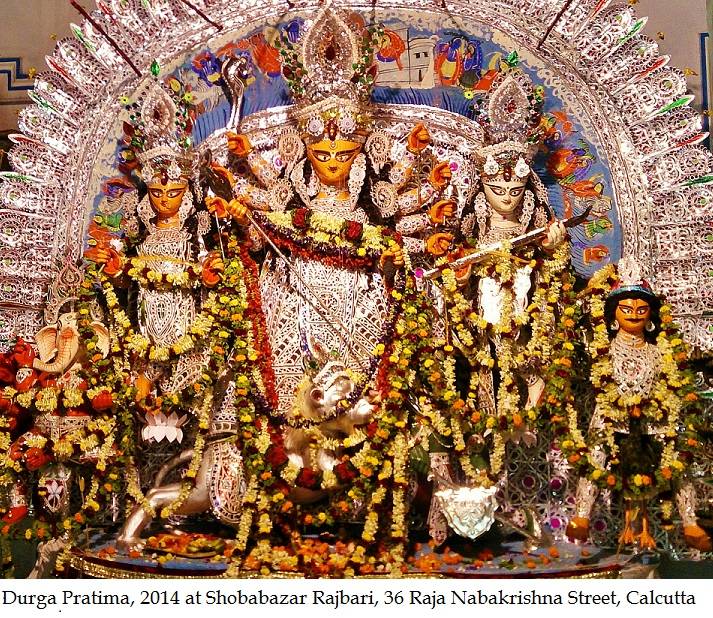
In an ironic twist of fate, perhaps the oldest Durga Puja celebration in the city and certainly the most opulent of the great old Houses of Calcutta – that of the merchant kings of Shobhabazar Rajbari in North Calcutta, celebrated in the quadrangle of a palace built by Raja Nabakrishna Deb – seems modest, downright humble by comparison, today.
And yet, in 1757, the Raja had hosted British major general, Lord Clive, at his palace, who having defeated the forces of Nawab Siraj Ud Daula, offered thanksgiving at the feet of the Goddess. Clive recognized the significance of routing the Nawab at Palashi (also known as The Battle of Plassy) in securing The British East India Company’s assets in the region, and wanted to give thanks but the only church in Calcutta was razed to the ground when the city was sacked a year earlier by the nawab’s forces.
Clive’s tutor-secretary or Munshi, Nabakrishna Deb, suggested he offer his thanks at Durga Puja to be held at his Rajbari.
‘But I’m a Christian,’ Clive is purported to have said. The pragmatic Raja promised that something could be ‘managed’. After all, Hindu scripture taught that all paths led to the same goal. (This, of course, was long before the Congress Party took credit for coming up with the idea of a secular India.)
Nabakrishna would go on to be named Taluqdar and Maharaja Bahadur with Clive’s backing, and The Deb family Puja, would kick-off the season, heralding the commencement of the festival with canon fire; their idols were also the first to be immersed each year in the river Ganges at the conclusion of festivities.
During this first grand Puja, wrote Jaya Chaliha and Bunny Gupta, authors of Calcutta The Living City, Volume II (Oxford University Press, 1990), the British were entertained with dancing girls, and were permitted to dine as they pleased with food and drink being brought from nearby Wilsons Hotel. This must have been done discretely so as not to offend the orthodox Hindus in attendance.
“And so Clive came to Shobabazar in the Black Town (sic, native-inhabited Calcutta),’ wrote Chaliha and Gupta. ‘A golden sofa was placed for him in the open quadrangle. The Durga Puja at 36 Raja Nabakrishna Street is still referred to as The Company Puja…which became a fashion and status symbol among the parvenu merchants.” (A quick note: this Puja actually took place at 33 Raja Nabakrishna Street, the original Rajbari. which was inherited by Gopimohun Deb, the Raja’s adopted son; the palace at 36 Raja Nabakrishna Street was built after Nabakrishna Deb’s biological son, Radhakanta Deb was born some thirty years later.)
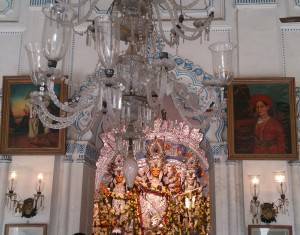 I do not see any golden sofa at the Burra (larger) Shobhazar Rajbari where I had been invited by the Deb family to share in the celebration. Absent too are European guests, though a ‘white’ tourist is taking pictures.
I do not see any golden sofa at the Burra (larger) Shobhazar Rajbari where I had been invited by the Deb family to share in the celebration. Absent too are European guests, though a ‘white’ tourist is taking pictures.
What I do see is a palatial colonial era property in decay, its size and architecture still evoking images of a bygone age, the lack of upkeep evidencing nobility lost. But there is something still stately about the place. The cracked concrete and chipped paint in the front of the building hide the antiquated opulence that lies beyond the doors.
In an enclave adjacent to the quadrangle, behind marble arches and portraits of the Deb family forefathers, stands a large but modestly decorated Durga Pratima, beautiful in its simplicity though elegant in presentation, perhaps not unlike the idols of old. The Goddess has been sculpted in the classic pose, her spear piercing the chest of the buffalo-headed demon Mahisasura upon whose body she stands. The female deities Saraswati and Lakshmi, representing knowledge and abundance are at her sides. Her sons, Ganesha and Kartikeya protect her flanks. The idols are made of simple mati or clay, painted with matte finish and bearing common ornaments.
A wooden rail protecting an area in front of the statues where priests had sat earlier, keep worshipers at a distance – but not me, for I am an honoured guest like Clive. And. I celebrate among imaginary Rajas, my hosts, admitting that they are princes in name only. Still, I cannot help but admire the perseverance of the family to keep the tradition going.
The city had long been associated with extreme poverty and filth by the Europeans and North Americans with whom I had mixed, growing-up in the West. I bore no small measure of shame at having roots in this reviled place, that my parents had been born there, my extended family still being residents were facts I filed away until we made our annual trips to India. The existence of such mansions, the Rajbaris as well as the thriving commerce and trade that took place in Calcutta during its prime – were all facts unknown to me, growing up. At the Deb’s home, my memories of disesteem, lajja as it is called in Bengali, are all but extinguished.
I notice the assistants cutting fruits and other offerings, gathering the ingredients, jogar for the Puja much as my mother and her peers do each year for my father and the other volunteer priests when they are called by the Bengali community in Ottawa to perform the ritual. The warmth of the atmosphere and my friendly hosts help make the Rajbari feel like home.
I had moved to Calcutta a few years ago from Canada, and have been bombarded with the sights and sounds of Pandals, at this time, since. I had conspired with my Western self to give the Puja a miss, this year, hoping to escape to the hills to work on my book but my wife and son objected. How could one imagine leaving the city during Pujo? Is this not a time for family and revelry?
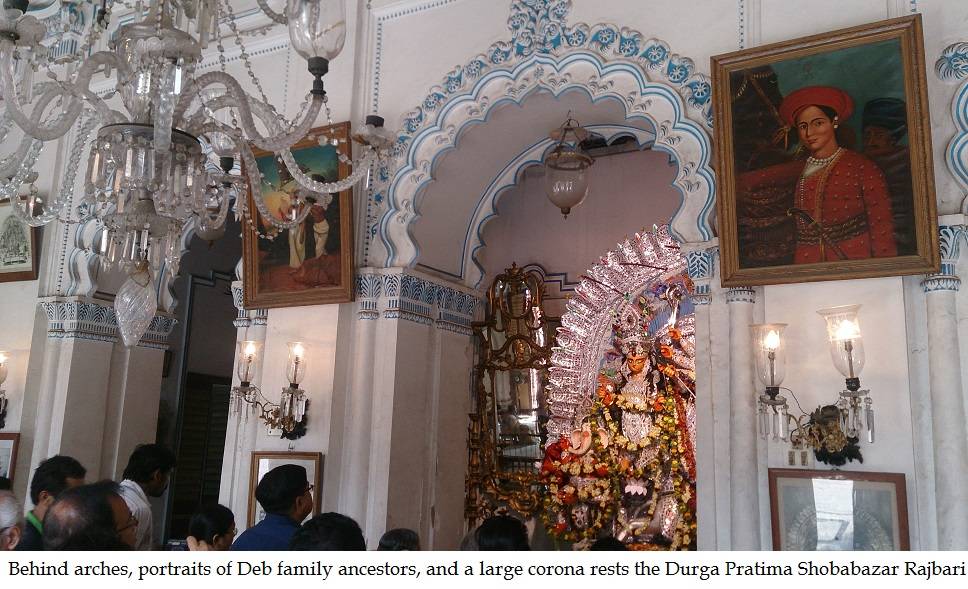 For me, Pujo as much a quiet personal time for introspection as much as it was for family. In Calcutta, though, amidst the crowds, the noise and the general chaos, my thoughts my thoughts cannot help but be jumpy, reactive rather than even.
For me, Pujo as much a quiet personal time for introspection as much as it was for family. In Calcutta, though, amidst the crowds, the noise and the general chaos, my thoughts my thoughts cannot help but be jumpy, reactive rather than even.
Back in Canada, with the festivities being timed around Canadian thanksgiving and university Homecoming, Durga Puja offered the opportunity to not only to reconnect but also to reflect. Non-Bengalis observing Navaratri and Dussehra would invite us to their celebrations and Bengalis reciprocated. Hindu immigrants from various Indian states gained the opportunity to connect in a kind of borderless republic. And I would directed my thoughts inward.
At Shobhabazar Rajpari, for first time during the Puja season in Calcutta, I find I can sit quietly in a familial atmosphere and think about the year that was as I had done back home. I think about my little boy, my wife, my family, the place I am in – and soon, I exist more in my thoughts than in a metropolis of some fourteen million souls.
I am charmed by the graciousness of my hosts, especially Tirthankar Krishna Deb and his uncle, Aloke Krishna Deb, scions of a class of urban noblemen whose grand patriarch had advised both generals and governors, and facilitated the fall of the Mughal hold over Bengal.
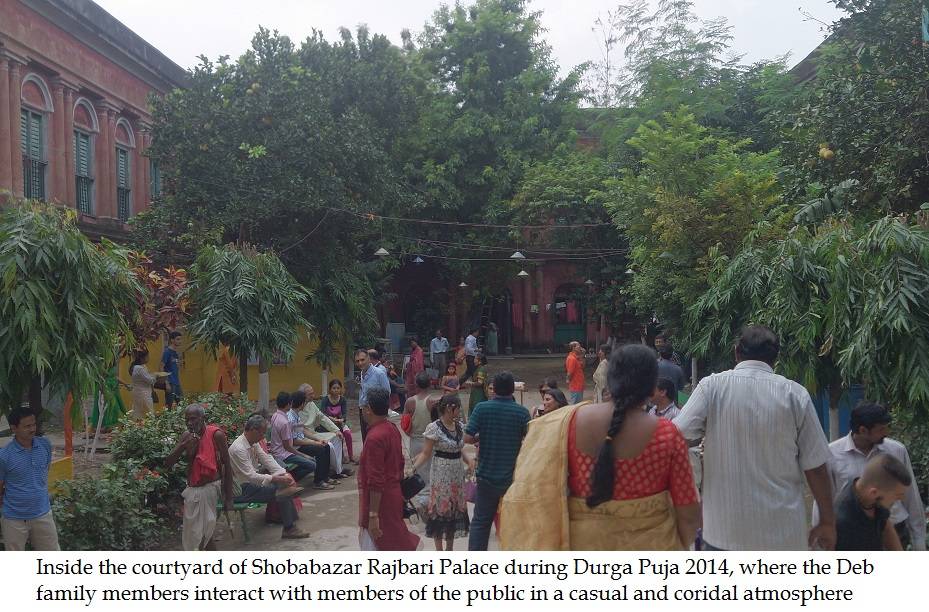
Renowned Sociologist, Benoy Ghosh referred to the Shobhabazar Rajbari Debs as among the most celebrated and powerful of the Raj era Zamindars. They held title to lands both in the North East and Bengal, including some property in present day Bangladesh, and significantly, nearly all of Sutanati, one of three villages, which The British East India Company amalgamated into Calcutta.
Present family head, Aloke Krishna Deb says he needs a museum with a library to adequately preserve all the documents regarding the large family’s history and their assets. Among them would be the deed to Sutanati, which was the centre of the textile industry in Calcutta.
The name of the neighbourhood derives from Shobaram Basak, the textile king of Calcutta, and a thriving textile bazar was situated there. A smaller market or haat still operates in the neighbourhood. Raja Nabakrishna deb is said to have bought the first Rajbari from Basak, and expanded it into a palace.
The Deb family, like other Zamindars were close to the British but unlike many of their ilk whose activities were limited to trade and influence peddling, the Debs were active in the cultural and intellectual life of the city. Nabakrishna Deb famously cultivated a large assembly of scholars and religious men at his court, “inviting some of the finest intellects from the traditional centres of learning at Shantipur and Nabadwip,” wrote scholar, Chitra Deb.
While Nabakrishna had been a patron of scholarship, his adopted son and heir, Radhakanta Deb was a scholar and writer, himself. And, he was a publisher. “His greatest feat was the publication of the Sanskrit encyclopedia, Shabdakapadruma in eight volumes over half a century at a cost of sixteen lakh rupees, from a press set up in his own house,” wrote Chitra Deb. The publication cost alone would be roughly $600,000 in present day funds (around 3.5 Crores of Rupees). She added, “He published his Bengali textbook, Shikshagrantha in 1821, and brought out Gourmohan Diyalankar’s book on female education, Streeshikshabidhayak, the same year…he also composed a book, Vedanta: What it is.”
A ‘BARIR’ PUJA
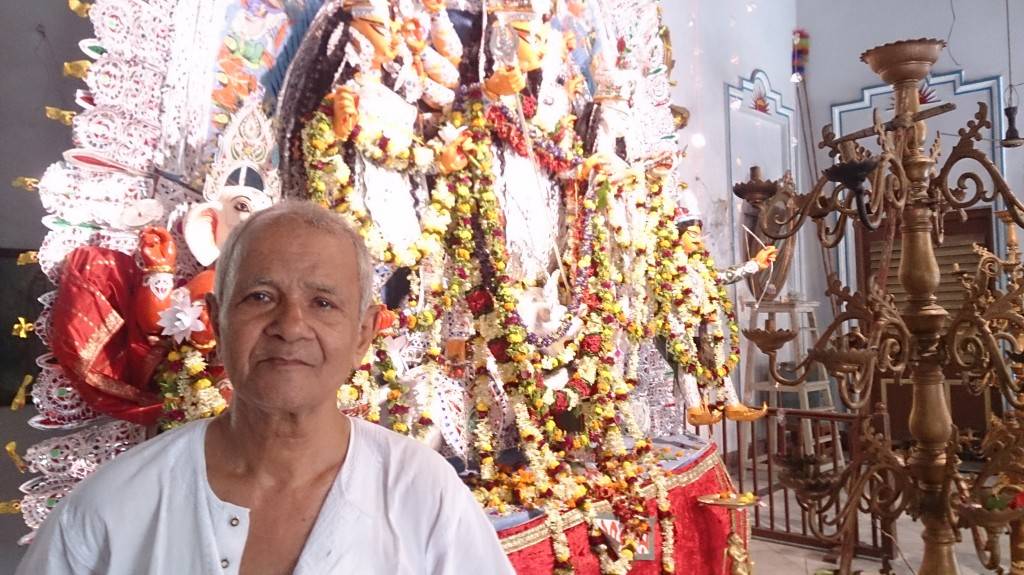
Aloke Krishna Deb with in front of the Durga Pratima at Burra Shobabazar Rajbari
It is legacy of which the present day Debs are proud. And while they do not have the means to continue it, they do what they can to honour the memory of their ancestors. A fit, white haired man, full of energy and sporting an undefeatable grin, Aloke Krishna Deb tells me to be at ease, that his family tradition is to treat their guests like living Gods, so they open their doors for the occasion each year.
Ordinary people stroll in an out of the palace; many are lined up for a meal of Bhog, food lovingly prepared and first offered to the Goddess. It is busy but not jammed like the Pandals. Perhaps there is nothing much for a pandal-hopper to gawk at, here. It is an occasion better suited to the devotee of history.
Still, they had their time, the Debs of Shobhaazar: The ostentatious nature of their festival was legendary, even around independence.
‘Just before 1947,’ says Aloke Krishna Deb, ‘when I was a boy, I remember around a hundred soldiers from the Scottish Highlands were brought in to play bagpipes for us,’
The pendulum has swung away: time, the abolition of Zamindari, and a famously stunting Raj era bureaucracy has denied them their wealth. Much of it lies in trust, and held by the High Court at Calcutta due to an inheritance dispute.
Mr. Deb is a retired Civil Servant; absent is the arrogance that often comes with massive means, ‘We are, after all, kings in name only, so we must be humble’ he says. ‘But we have upheld the traditions of our ancestors – only the quantity (of celebration) is less.’
He bounds with youthful vigour from one end of the quadrangle to another, taking care of this arrangement, that detail, talking to a stray person. His booming voice is a result of hearing loss but this seems to be the only diminishing distinction of age. Nearing eighty, he attributes his good health and energy to his devotion to the family deity, Gopinath Jiu, who resides on the first floor of their home. His ancestors, the Radhakanta line of succession, accepted a less valuable inheritance than those of Nabakrishna Deb’s other son’s family because the lesser lands came with their beloved idol. Flush with wealth and power, in the end, Radhakanta’s devotion to the deity was what he held most dear. This devotion has flowed down nearly twenty generations, and it has kept them modest in the process.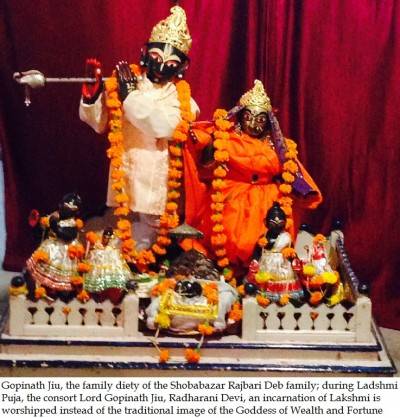
“We are simple people,’ he says, “and we are conservative as shown by our dress and manner.” He wears a white cotton Kurta Pajama, his hands absent the bulky rings that can be seen weighing down the fingers of his counterparts in Bengali society – both old and new; there is no gold chain around his neck. It is as though he knows these trinkets however valuable, are instruments of bondage, and flits freely unencumbered by them.
The members of this once landed family, still proud of their storied past, exhibit a humility that exists in stark contrast to the increasingly consumerist pastime of new Kolkata – showing off.
TWO DEMONS
The irony of Calcutta’s Pandal culture is thick as the camphor.
Legend has it that two demons were vanquished by The Goddess Durga and her other manifestation, Kali as described in the ancient Upanishad scriptures called the Devi Puranas. Durga Puja celebrates the triumph over one of the demons – Mahisashura; Kali Puja – victory over the other – Raktabija.
According to scripture, Mahisasura’s father, Rambha, a demon king, had fallen madly in love with Mahishi, an Asura who could transform into a buffalo at will, at times maintaining hybrid form. He took her as his wife – and while with child, she was abducted by an ex-lover from her abode. The two fought; Rambha was killed.
Devastated, a grieving Mahishi leapt on to Rambha’s funeral pyre – an act which moved Lord Yama, God of Death. He halted the migration of Rambha’s soul, and redirected it into Mahishi’s womb. Out of the cremation fire emerged twins: Mahishasura, the son conceived of Rambha and Mahishi; and Raktabija, the reincarnated Rambha.
Mahishasura was a great soldier and his penances garnered him a boon from Lord Brahma, the creator in the Hindu pantheon. Arrogance would be his undoing: he asked to be impervious from death by either man or god, for surely he had nothing to fear from a mere woman.
Raktabija had also gained a special power: wherever his blood would fall, his seed would sprout, and he would be duplicated.
The demon army led by these twins were terrorizing the known worlds. So, the Devas (Demi-Gods) appealed to the holy trinity Brahma, the Creator, Vishnu, the Preserver, and Shiva, the destroyer to eliminate the threat. Together, they created the ten armed Goddess, Durga. They, along with the Devas armed and empowered her. In turn, she manifested their combined power.
Unprotected from being killed by a female and underestimating the female he faced in battle, Mahishasura proposed marriage to Durga when he met her on the battlefield. He, being ego personified left her enraged at his arrogance. In killing him, Durga demonstrates that we must conquer our ego on the path to enlightenment.
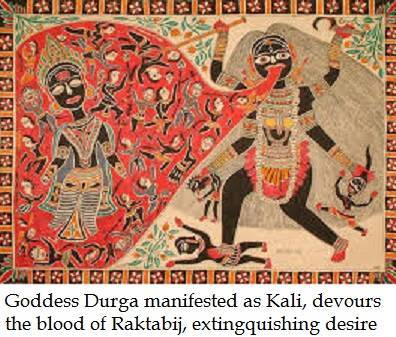 Similarly, Raktabij represents desire for which there is no end to satisfaction – one drop of blood begetting another demon, one craving satiated giving rise to another one. Durga, assuming the form of Kali, cut the head off of Raktabij and drank all of his blood, so not even a single drop would fall: her solution being to eliminate all desire before it has a chance to sprout.
Similarly, Raktabij represents desire for which there is no end to satisfaction – one drop of blood begetting another demon, one craving satiated giving rise to another one. Durga, assuming the form of Kali, cut the head off of Raktabij and drank all of his blood, so not even a single drop would fall: her solution being to eliminate all desire before it has a chance to sprout.
Thousands of years after the legend became known, these demons seem to have reincarnated in the Pandal culture of modern Kolkata. The displays are all about ego, and the culture of consumption it celebrates is rooted in desire. I wonder to myself, will Calcuttans ever conquer these demons? Certainly not during the festive season.
Asked about the Pandal culture, Aloke Krishna Deb is ambivalent, ‘They are what they are – I don’t want to criticize them but that is not Puja. That is all pomp and grandeur. I have no quarrel with them. Let them enjoy.”
Presumably his family also enjoyed, I suggest, having read about the famed pageantry of their house. Concurring, he volunteers to elaborate, ‘Yes. In fact, I have seen a lot of pomp and grandeur since I was a boy at our home – dance, theatre, Kobi-loray (poetry recitation competitions). We used to start our Puja with the firing of a canon! I have seen all this – but we always followed the rituals seriously, being conservative Hindus: there was no surrender on this matter. Now, there is no more pomp and grandeur but we are still following the rituals with utmost dedication.’
He adds: ‘Ours is a Barir Puja (House Puja) – that is to say, we follow all the rituals, and that is our focus. Every year, we welcome the Goddess as a daughter returning to her father’s home – and we do so with love.’
Kolkata, it appears, has turned Calcutta on its head. The socially significant Barowari Pujas, which were established so the public dare not depend on the benevolence of the wealthy have devolved into mere corporate events, the community, transformed into event managers, the public reduced to the role of gawker, tourists in their own land. This is the impact of Durga Puja Inc. At the same time, the Shobabazar Rajbari Puja, no longer The Company Puja for the presence of the British, has become a simple Barir Puja – a conclusion, which by comparison is far more awe-inspiring than the palace walls that house it.
For video, click here: Shobhabazar Rajbari Dashami Puja
 The Global Calcuttan Magazine
The Global Calcuttan Magazine
Great article! People have forgotten the Banedi Bari Pujas, now the Barowari Pujos are more elaborate.
excellent piece – very informative and well written!
Wonderful wonderful article. So well researched an beautifully explained.
If these Rajas had money they would be doing same thing as clubs. Evey body is showoff
Perhaps this is the case but it is true that the community spirit of Barowari Pujas has been taken over by commercial interests. The history of the Deb family was fascinating, though. We don’t know our own history in Bengal. That’s a shame.
credit to this website for giving us the lessons
This article shows the transformation of “Puja now” from “Puja then” with the hidden interpretation of the DURGA PUJA. It is a wonderful exposition from someone who has grown up in this transition period. Personally, I would like to read more from you in another article where you could portray where we are going in the digital age.